Activities - Benjamin-Mills
Activities - Benjamin-Mills
Activities - Benjamin-Mills
You also want an ePaper? Increase the reach of your titles
YUMPU automatically turns print PDFs into web optimized ePapers that Google loves.
WM1The origins anddevelopment of themodern pharmaceuticalindustryIn this activity your class will divide into threegroups. Each group will prepare a short presentationon one of the following topics.1 Folklore in medicine2 Medicine discovery and the nation’s health3 The British pharmaceutical industryFinding informationYou are expected to research your topic by searching the Internet. Start bylooking at the Salters Advanced Chemistry web site which will link you to othersites which are relevant. Some suggestions for the focus of your research andhow you might organise your presentation are given below for each topic.1: Folklore in medicineA suggested format for your presentation is a discussion between two people,one arguing the case based on your research, for traditional remedies, the otherthe case of someone who does not believe in folk medicine.The case against might include some of the following points.●●●We are civilised now: we don’t believe in medicine men, voodoo andsuperstition.Most of these medicines work by ‘the placebo effect’ – people believe themedicines are going to make them better, so they do. Take away the primitivebeliefs and the medicines won’t work.In primitive communities it was kill or cure. Any medicine was better thannone.2: Medicine discovery and the nation’shealthYour group, in addition to searching the Internet, will look at part of theAssociation of the British Pharmaceutical Industry’s publication an A to Z ofBritish Medicines Research, given below and in Figure 1, and at a table of deathsfrom various diseases since 1935 (Table 1).Here are some of the questions you might like to consider in your researchand presentation.●●●●Is there a link between trends in deaths from disease and the discovery ofmedicines?What other causes of longevity are there as well as improvement of medicines?What are the main killers today? What will happen when they are tamed?Is death rate a good measure of the nation’s health? What other measures arethere?Extract from an A to Z of British Medicines ResearchThe past fifty years of British medicines researchThe past 50 years have seen a revolution in our understanding of disease and itstreatment (Figure 1). It has been a half century in which:●●●●●organ transplantation has become accepted as commonplacethe structure of DNA was elucidated, opening the way for the sciences of geneticengineering and genomicsinterferon, the first of a family of naturally occurring molecules called cytokines,was isolated and namedmonoclonal antibodies were discovered, opening the way for the specifictargeting of medicinessmallpox, a centuries-old scourge of mankind, was eradicated from the planet134AS LEVEL„ Salters Advanced Chemistry 2000 – see Copyright restrictions
THE ORIGINS AND DEVELOPMENT OF THE MODERN PHARMACEUTICAL INDUSTRYWM1●●●techniques for in vitro fertilisation were developed, bringing family joy to manychildless couplesAIDS emerged and with it the discovery of a family of human viral pathogenscalled retroviruses, of which HIV is one, leading to entirely new medicines tocontain the virusadvanced scanning techniques were developed which have transformed thediagnosis and understanding of many human diseases.Built on these and many other developments, there has also been a revolution inthe number, specificity and safety of human medicines. It is here as much asanywhere that Britain has been in the front line: for the whole of the last half century,medical and medicines research in Britain has been the envy of the world for itsinnovative skills and high ethical standards. Even today, despite increasingpressure on funding and demands for greater safety in medical products, we stillenjoy this reputation. British hospitals are often a first choice for assessing thevalue of new medicines. Many European, Japanese and American ownedpharmaceutical companies choose to fund major research groups here. It is noaccident that today 7 of the top 25 medicines in the world, and 6 of the top 12medicines used to treat bacterial and viral infections, are the products of Britishpharmaceutical research.But the industry can also be proud of the contribution it makes to the Britisheconomy. UK earnings from the export of medicines exceeded imports by £2.3billion in 1997. On top of that, the industry employs the skills of more than 60 000people, including 20 000 highly-trained scientists and doctors.Disease 1935 1945 1955 1965 1975 1985 1995Scarlet fever 499 82 21 1 – – –Whooping cough 1473 689 88 21 12 4 2Diphtheria 3408 694 13 – 1 – 1Measles 1264 728 176 115 16 11 1Typhoid 170 44 15 8 1 – –Tuberculosis (respiratory) 23 840 19 668 5837 2008 722 408 355Syphilis 3521 2378 1385 857 110 40 9Heart disease(circulatory system) 103 613 127 969 138 313 151 718 299 669 287 054 241 871Cancer 62 602 73 753 91 340 106 474 123 769 141 618 140 791Total deaths 477 401 481 274 518 864 549 379 582 841 590 734 565 902Population (million) 40.65 42.63 44.44 47.67 49.47 49.99 51.52Table 1 Deaths from various diseases in England and Wales, 1935–1995 (The Stationery Office Annual Abstract of Statistics)A glossary of some of the diseases in the tableScarlet fever Infectious disease. High fever, sore throat. Caused bystreptococcal bacterial infection.Whooping cough Infectious disease of mucous membrane of air passages.Frequent attacks of convulsive coughing caused by bacteria. Vaccination possible.Diphtheria Infectious disease causing growth of membrane, often on tonsils,making swallowing difficult. The bacterium produces a toxin. Vaccination beganin 1940.Measles Viral infection. Causes fever and rash. Vaccine available.Typhoid A fever with ulceration of skin and bowels. Bacteria carried in sewagewhich is main cause of contagion.Tuberculosis Disease of lungs and other organs caused by bacteria. Improvedhygiene, vaccination and chest X-rays have helped to minimise its effects.Syphilis A sexually transmitted (or inherited) disease. Slow to manifest itself.Caused by a spirochaete. Results in death unless checked.AS LEVEL„ Salters Advanced Chemistry 2000 – see Copyright restrictions135
THE ORIGINS AND DEVELOPMENT OF THE MODERN PHARMACEUTICAL INDUSTRYWM13: The British pharmaceutical industrySearch the Internet and look at the data provided (which come from TheAssociation of the British Pharmaceutical Industry).Here are some of the questions you may wish to address in your research andpresentation.●●●●How important is the pharmaceutical industry in national terms to theeconomy?How has the industry grown over the years?Into which categories can the products of the industry be usefully divided?How important is the British pharmaceutical industry internationally?Trade surplus /106£Petroleum, Power machinery etcgeneratingMedicines and pharmaceuticalsSpecialised machineryChemical materials and productsTelecommunicationsScientific equipmentEssential oils and perfumesTobaccoIndustrialDyeing, tanningmachineryand colouringGas, natural and manufacturedOrganic chemicalsBeverages40003000200010000Figure 1 UK visible trade surpluses in 1998Output / 106£12 00010 0008000KeyOver-the-counter (OTC) medicinesExportsNHS sales6000400020001960 1970 1980 1985 1990 1992 1994 1996 1998Source: Pharma, Facts and Figures, Association of the British PharmaceuticalIndustry, 2000Figure 2 British pharmaceutical industry outputby market sectorsAS LEVEL„ Salters Advanced Chemistry 2000 – see Copyright restrictions137
WM1THE ORIGINS AND DEVELOPMENT OF THE MODERN PHARMACEUTICAL INDUSTRYExports Imports Balance Exports per All UK exports/10 6 £ /10 6 £ /10 6 £ employee/£ per employee/£1981 852 298 554 12 206 63451982 978 375 603 14 257 70881983 1074 470 604 15 817 79781984 1222 542 680 18 077 94201985 1426 590 835 21 315 10 5201986 1533 679 853 23 991 11 2051987 1621 786 835 24 339 12 7121988 1735 876 859 25 628 13 6751989 2016 1062 955 28 315 15 8161990 2258 1158 1100 31 759 17 8731991 2556 1371 1184 35 104 20 0191992 2993 1663 1330 40 553 21 7441993 3710 2019 1691 53 927 25 1131994 4005 2304 1701 57 705 28 5821995 4939 2812 2126 79 784 31 9251996 5386 3107 2279 91 597 34 3861997 5455 3192 2262 90 912 * 35 4961998 5860 3418 2442 97 667 * Table 2 British pharmaceutical trade figures* Subject to revisionSource: Pharma, Facts and Figures, Association of the British Pharmaceutical Industry, 2000Exports Imports Trade balance/10 6 £ /10 6 £ /10 6 £Germany 7741 4179 3562Switzerland 4904 2115 2790UK 5860 3418 2442Ireland 2620 486 2134France 5193 3507 1685Sweden 2142 739 1403Belgium 3056 2380 676Denmark 620 471 150Netherlands 1967 2043 –76Austria 809 1058 –249Italy 2344 2596 –252Finland 138 394 –255Portugal 87 441 –358Greece 70 600 –530Australia 393 988 –596Spain 743 1572 –828Canada 675 1525 –850US 4817 5687 –870Japan 686 1948 –1262Source: Pharma, Facts and Figures, Association of the British Pharmaceutical Industry, 2000Table 3 World pharmaceutical trade figures, 1998138AS LEVEL„ Salters Advanced Chemistry 2000 – see Copyright restrictions
WM2Extraction of salicylicacidIn this activity you can extract some salicylic acid, apharmacologically active compound from a naturalsource, oil of wintergreen, which is obtained in turnfrom the shrub Gaultheriae procumbus. You then learnthe technique of thin-layer chromatography and use itto compare the extract with a pure sample of salicylicacid.Requirements● oil of wintergreen (2 cm 3 )● apparatus for heating under reflux (see Figure 1)● sodium hydroxide solution, 2 mol dm –3 (25 cm 3 )● measuring cylinder (25 cm 3 )●●anti-bumping granulessmall Bunsen burner or electric heating mantle● 100 cm 3 beakers (2)●ice (if available)● concentrated hydrochloric acid (a few cm 3 )●●●●Universal Indicator paperglass rodBuchner funnel and apparatus for vacuum filtrationwatch glass● ethanol (a few cm 3 )●●●t.l.c. plates (silica-coated)small beaker to hold t.l.c. platecover for the beaker● solution of salicylic acid in ethanol (1 cm 3 )●solvent for chromatography – cyclohexane, ethylethanoate, ethanoic acid (200:100:1)● dropping tubes or melting-point tubes (2)●●●u.v. light sourceiodine crystalsaluminium foil or clingfilmcyclohexaneglacial ethanoic acidethanolethyl ethanoateconcentrated hydrochloric acid2-hydroxybenzoic acid(salicylic acid)iodineHIGHLY FLAMMABLECORROSIVEHIGHLY FLAMMABLEHIGHLY FLAMMABLECORROSIVEIRRITANTHARMFULFLAMMABLECARE Ultraviolet radiation is harmfulto the eyes. Do not look directly atthe lamp. Follow the recommendedprecautions concerning eye protection.ULTRAVIOLET RADIATIONmethyl 2-hydroxybenzoate,methyl salicylate(oil of wintergreen)HARMFULCARE Eye protection must be worn.WEAR EYE PROTECTIONsodium hydroxide solutionCORROSIVEIntroductionThe ester methyl salicylate found in nature can be convertedinto salicylic acid. It is obtained as oil of wintergreen whichused to be made by dry distillation of the leaves of theevergreen shrub Gaultheriae procumbus prevalent in the US.You may be familiar with the smell of the ester for it is presentin many medicinal preparations (for example ‘Deep Heat’ andother similar ointments used to relieve muscle pain).In this experiment you will obtain salicylic acid from themethyl ester by hydrolysis, using dilute sodium hydroxidesolution.AS LEVELWhat you do„ Salters Advanced Chemistry 2000 – see Copyright restrictions1 Put about 2 cm 3 of oil of wintergreen (CARE Harmful) intoa 50 cm 3 pear-shaped flask and add 25 cm 3 of 2 mol dm –3sodium hydroxide solution (CARE Corrosive) togetherwith a few anti-bumping granules.2 Attach a water condenser to the flask in a vertical position(see Figure 1) and gently heat the mixture under reflux for 30minutes. Make sure the condenser water supply is on. Youcan heat the flask with a small Bunsen flame below a wiregauze or use an electric heating mantle. When the mixture isboiling, condensed droplets should be falling back into theflask at a rate of about 1 drop per second.139
WM2EXTRACTION OF SALICYLIC ACID3 Allow the mixture to cool and pour it into a 100 cm 3 beaker surrounded bycold water (and ice, if available). Using a dropper, add concentratedhydrochloric acid drop by drop (CARE Corrosive) until the mixture is acidic.Test the mixture, as you add the acid, with Universal Indicator paper, using aglass rod and small drops of the mixture.4 Using a Buchner funnel, filter the product using vacuum filtration. Wash thesolid with a little cold water and transfer it to a watch glass.5 Take a few crystals of the product and dissolve them in a minimum of ethanol.6 Take a pre-dried thin-layer chromatography plate which will fit into a smallbeaker (see Figure 2). About 1 cm from the bottom of the plate draw a finepencil baseline. On the line place a small spot of the extract from stage 5. Onthe baseline also put a small spot of a solution of salicylic acid in ethanol.The spots are best made using a very fine dropping pipette or a drawn-outmelting-point tube. Apply a small quantity of the solution at a time; let it dry,and then add more. Try not to let the diameter of the drops exceed 5 mm.7 Place some solvent for the chromatograpy in the beaker to a depth of about5 mm. (CARE Highly flammable. Avoid breathing the vapour.)8 Place the chromatography plate in the beaker, making sure the solvent isbelow the pencil line on the plate.9 Cover the beaker, for example with aluminium foil or a watch glass. Leavethe solvent to rise up. This will take about 15–25 minutes.10 When the solvent has nearly reached the top of the plate, take thechromatogram out of the beaker. (CARE Avoid breathing the solvent vapour.)Place the plate in a fume cupboard and allow the solvent to evaporate.11 You can locate the positions of the substances on the plate by examining itunder u.v. light. (CARE Do not look directly at the light source.) View theplate by reflected light.12 Alternatively, place the sheet in another beaker with a few crystals of iodine(CARE Harmful. Avoid skin contact. Use in a fume cupboard.) Cover thebeaker with aluminium foil or clingfilm. The spots which were probably justvisible before should show up more clearly now. After the experiment,dispose of the solvent as directed by your teacher.water inantibumpinggranulesHEATwater outoilwintergreenofsodium hydroxide+solutionFigure 1 Apparatus for heating under refluxthin-layer platesalicylicsolutionacidextractfromwintergreenoil ofsolventlidFigure 2 Apparatus for thin-layer chromatographyQUESTIONSa Explain what is meant by heating under reflux.Why is this often necessary when heatingorganic liquids?b Why is it necessary to heat the flask for sucha long time?c What do the results from the thin-layerchromatography separation tell you about thecomposition of the extract from oil of wintergreen?d The equations for the reactions occurring in theexperiment are shown on the right. How couldyou have obtained the methanol formed duringthe experiment if you had wished to use it?e Suggest why the mixture formed by the hydrolysisof the ester was kept as cool as possible.OCOHoil of wintergreenCOHCOO++ CH 3 OHCH 3O+H +OHOHCOHsalicylic acidO140AS LEVEL„ Salters Advanced Chemistry 2000 – see Copyright restrictions
WM3Investigating thechemistry of the–OH group in variousenvironmentsThe hydroxyl (–OH) group occurs in three types oforganic compound: alcohols, phenols and carboxylicacids. Examples are:CH 3 CH 2 OHethanol phenol ethanoic acidThe object of Part 1 of this activity is to investigate thebehaviour of the –OH group in these three compoundsand to compare this with the behaviour of2-hydroxybenzoic acid (salicylic acid).In Part 2 you can compare the behaviour of the –OHgroup in different alcohols.OHCH 3COOHRequirements●●●●small quantities of:– ethanol, labelled A– phenol (saturated solution in water), labelled B– ethanoic acid (2 mol dm –3 solution), labelled C– glacial ethanoic acid (for test 6)– 2-hydroxybenzoic acid (salicylic acid), solid, labelled Dprotective glovesUniversal Indicator solutioniron(III) chloride solid● potassium dichromate(VI) solution, 0.1 mol dm –3 (2 cm 3 )● methanol (5 cm 3 )●concentrated sulphuric acid (access to bottle)● sulphuric acid, 2 mol dm –3 (5 cm 3 )● sodium carbonate solution, approximately 0.5 mol dm –3●(200 cm 3 )test-tubes● 100 cm 3 beakers (8)●●a range of alcohols:– propan-1-ol (3 drops)– butan-1-ol (3 drops)– butan-2-ol (3 drops)– 2-methylpropan-2-ol (3 drops)source of hot waterCARE Phenol can cause sores and blistering if spilt on theskin. Glycerol, propane-1,2,3-triol, can be applied tocounteract phenol burns.CARE Alcohols are highly flammable liquids.Keep bottles stoppered when not in use and well awayfrom naked flames.Avoid skin contact and do not breathe the vapour.CARE Dichromates(VI) irritate the skin. They are alsosuspected carcinogens. Avoid all skin contact. Anyspillage should be washed off at once. Wear protectivegloves.glacial ethanoic acidethanol2-hydroxybenzoic acid(salicylic acid)iron (III) chloridemethanolphenolpotassium dichromate(VI)solutionpropan-1-olbutan-1-olbutan-2-ol2-methylpropan-2-olsulphuric acidCARE Eye protection andgloves must be worn.CORROSIVE FLAMMABLEHIGHLY FLAMMABLEIRRITANTIRRITANTTOXICTOXICTOXICHARMFULCORROSIVEHIGHLY FLAMMABLECORROSIVEHIGHLY FLAMMABLEPROTECTIONWEAR EYEPROTECTIVEWEARGLOVESAS LEVEL„ Salters Advanced Chemistry 2000 – see Copyright restrictions141
WM3INVESTIGATING THE CHEMISTRY OF THE –OH GROUP IN VARIOUS ENVIRONMENTSPart 1: Comparing ethanol, phenol,ethanoic acid and 2-hydroxybenzoic acid●●●●Substance A is the alcohol ethanol (CARE Highly flammable).Substance B is a solution of phenol (CARE Toxic and corrosive. Avoid all skincontact. Wear gloves).Substance C is a solution of ethanoic acid. Ask for a more concentratedsample for test 6. (CARE Concentrated ethanoic acid is corrosive and has anirritant vapour. Avoid skin contact and inhalation.)Substance D is 2-hydroxybenzoic acid (salicylic acid) (CARE Irritant). Thetests on D can be carried out either with the solid or with a concentratedsolution, whichever seems more appropriate.Look quickly through the tests you will be doing, and draw up a table to presentyour results.For each test use 1 cm depth of the sample solution or a small spatulameasure of solid.OHCOOH2-hydroxybenzoic acid(salicylic acid)What you do1 To each of the substances in turn add a few drops of Universal Indicatorsolution, and record the pH value.2 To each of the substances in turn add an equal volume of aqueous sodiumcarbonate and warm. Test for any gas evolved.3 Dissolve a small spatula measure of solid iron(III) chloride (CARE Irritant;stains skin and clothing) in about half a test-tube of water. Divide thesolution equally among four test-tubes and add a small quantity of eachsubstance in turn to the tubes. Record any colour changes.4 To about 1 cm depth of 0.1 mol dm –3 potassium dichromate(VI) solution(CARE Toxic) in a test-tube add 2 mol dm –3 sulphuric acid (CARE Corrosive)until the tube is half-full. Divide this solution among four test-tubes and addsmall quantities of each substance in turn. Warm the mixtures in their testtubesin separate 100 cm 3 beakers of boiling water and record any colourchanges. (You will need the beakers of hot water again in stage 6.)5 Cautiously smell samples of A, B, C and D in turn. Make a note of theirsmells.6 Put 1 cm 3 of each substance in turn into a test-tube. In the case of ethanoic acid,use the concentrated (‘glacial’) acid rather than an aqueous solution. (CAREConcentrated ethanoic acid is corrosive and flammable.) Then to each add anequal volume of methanol and a few drops of concentrated sulphuric acid(CARE Corrosive). Warm each tube and its contents gently for a few minutes inhot water in a beaker. Pour the hot solutions into beakers of dilute sodiumcarbonate solution. This neutralises any acid which remains and so removes itssmell. Cautiously smell the contents of the beakers. Note any changes ofsmell.What do you do if the organicmaterial catches fire?Do not panic!Place the test-tube in the rack and place awet cloth over the top.Do not run around with the test-tubeon fire.Do not use a fire extinguisher for a smallfire in a test-tube.QUESTIONSa Look at the results of the tests for substance D. In what way doessubstance D show similarities to those for the other compounds?b What conclusion can you draw about the environments of the –OHgroups in 2-hydroxybenzoic acid?142AS LEVEL„ Salters Advanced Chemistry 2000 – see Copyright restrictions
INVESTIGATING THE CHEMISTRY OF THE –OH GROUP IN VARIOUS ENVIRONMENTSWM3Part 2: Comparing different alcohols1 Place about 1 cm depth of 0.1 mol dm –3 potassium dichromate(VI) solution ina test-tube. Add 2 mol dm –3 sulphuric acid until the tube is half full. Thendivide this mixture as equally as possible between five test-tubes.You are going to investigate the effect of this oxidising mixture on a rangeof alcohols, for example ethanol, propan-1-ol, butan-1-ol, butan-2-ol and2-methylpropan-2-ol.2 Add 3 drops of one of the alcohols to the oxidising mixture in one of thetubes. Be careful not to add too much alcohol. (CARE Alcohols are highlyflammable. Keep the bottle well away from naked flames.)Carefully warm the contents of the tube until they just begin to boil.(CARE Do not continue to boil the liquid in case alcohol vapour catches fire.)3 Label the tube and leave it to stand. Repeat the procedure in step 2 witheach of the other alcohols.4 Make a note of any changes of appearance of the mixtures in the tubes. Workout what has happened in each case, and present your results in the form ofa table showing the structural formulae of the alcohols and any productswhich are formed.QUESTIONSc There is a pattern in the behaviour of the alcohols towards oxidation.Describe the pattern.d There are three different structural types of alcohol in this investigation.Suggest why the three types behave differently. Building models of aseries such as butan-1-ol, butan-2-ol and 2-methylpropan-2-ol mighthelp you see more clearly what is happening.AS LEVEL„ Salters Advanced Chemistry 2000 – see Copyright restrictions143
WM4Interpretation of themass spectrum ofsalicylic acidIn this activity you will practise some of the ideas youare learning about mass spectrometry, and see howchemists can identify a substance from its massspectrum.Before starting the activity you should be familiarwith the technique of mass spectrometry. If necessary,read about this in Chemical Ideas 6.5.This activity guides you through a sequence of steps which a chemist could takewhen using mass spectra data to confirm the structure of a substance extractedfrom willow bark and given the name salicylic acid. You can record the evidence asyou acquire it on the Information Sheet (Mass spectrum data). Rememberresearch chemists, when publishing their findings, must supply as much evidenceas possible to confirm the structure they propose for a compound even if, whenmore limited evidence is available, they already feel confident about the structure.Finding possible formulae1 Look first at Figure 1, the mass spectrum of salicylic acid. Measure therelative abundance of the six marked peaks. Record the mass andabundance of each peak in the appropriate box towards the bottomof the Information Sheet.100120Figure 1 The mass spectrum of salicylic acid80Intensity / %60402039 63 64 9213800 20 40 60 80 100 120 140 160Mass2 Decide which of these peaks gives the molecular mass of the compound.A computer database can list the possible molecular formulae that will fit this value.There can of course be a very large number. One limited database gives 38compounds for this molecular mass. Add this number to the Information Sheet.Using isotope peaks to establish theformulaThe number of possible compounds can be reduced by using the highresolutionmass spectrum facility. For the willow bark extract this gives anaccurate molecular mass of 138.0317. In the same database there are only twocompounds with this value: they are C 2H 7ON 4Cl and C 7H 6O 3. Add these possiblemolecular formulae to the Information Sheet.Naturally occurring carbon consists of a mixture of isotopes. Most carbon is 12 C,but 13 C is present as 1.1% of the sample. If the active chemical in the extractcontains one carbon atom in its molecule, the molecular ion peak at a mass Mshould be accompanied by another peak at M+1 with approximately 1.1% theintensity of the molecular ion peak. Two carbons will give rise to an M+1 peak ofapproximately 2.2% relative intensity, and so on.This means that for one carbon atom, the ratio of the intensities of M : M+1peaks will be 98.9 : 1.1; for two carbon atoms the ratio will be 97.8 : 2.2, and so on.144AS LEVEL„ Salters Advanced Chemistry 2000 – see Copyright restrictions
INTERPRETATION OF THE MASS SPECTRUM OF SALICYLIC ACIDWM43 Figure 2 gives a more accurate mass spectrum for salicylic acid. Thisspectrum shows any isotope peaks which exist. The intensities of themolecular ion peaks have been accurately measured and are given on theInformation Sheet.1008091.9868120.0211Intensity / %60402039.023253.003764.037000 20 40 60 80 100 120 140 160MassFigure 2 A more accurate version of the mass spectrum of salycylic acidUsing a database to establish which isomerit isA web site, which supplies mass spectra of compounds, indicates that there arethree isomers with the molecular formula C 7H 6O 3. The mass spectra of thesecompounds provides the following information.138.03172-hydroxybenzoic acidPeak 120 92 138 64 39 63Intensity 100 73 39 19 14 143-hydroxybenzoic acidPeak 138 121 93 65 39 91Intensity 100 75 23 16 12 124-hydroxybenzoic acidPeak 121 138 65 93 39 63Intensity 100 83 24 22 18 104 Which of these matches the spectrum of salicylic acid? Write the chemicalname and structure of salicylic acid on the Information Sheet.Table 1 Mass spectra of the three hydroxybenzoicacidsConfirming the structure using thefragmentation patternMass spectrometrists can find out a lot about the structure of a molecule bylooking at the fragmentation pattern in the mass spectrum. This provides anadditional way of distinguishing 2-hydroxybenzoic acid from its two isomers, 3-and 4-hydroxybenzoic acid. It may help with this activity to build models of thethree molecules.5 Using Table 1, write down the peaks in the mass spectrum of2-hydroxybenzoic acid that are not shared by 3- and 4-hydroxybenzoic acid.6 Which well-known molecule with M r= 18 might be lost in the conversion:138 (the whole molecule) Æ 120in 2-hydroxybenzoic acid?7 What are the two most likely ways in which the molecule in 6 can arise from2-hydroxybenzoic acid? Show this by ringing the relevant atoms on drawingsof the structure of the molecular ion of 2-hydroxybenzoic acid (Figure 3).8 3- and 4-hydroxybenzoic acid do not have the same fragmentation patternbecause they cannot form an ion of mass = 120. Explain why this ion cannotform.AS LEVEL„ Salters Advanced Chemistry 2000 – see Copyright restrictionsC OH +OOHFigure 3 The molecular ion of 2-hydroxybenzoicacid145
WM4INTERPRETATION OF THE MASS SPECTRUM OF SALICYLIC ACIDInformation Sheet: Mass spectrum dataApproximate molecular mass(found by fast, low-resolution scan)Number of possible molecular formulaeAccurate molecular mass(measured by slower, high-resolution scan)Possible molecular formulaeIsotope peaksA group of peaks starting at the parent ion peak, due to isotopes of carbon. These peaks may besmall on the spectrum, but are given here scaled up so that the largest peak in this group has abundance 100.Molecular ion peak = 100% Indicated number of carbon atoms:M + 1 peak = 8.2%Six largest peaks in the spectrumMassRelativeabundanceIdentity of this sample146AS LEVEL„ Salters Advanced Chemistry 2000 – see Copyright restrictions
WM5.1A preparation of aspirinThis activity is an example of an organic preparation.You will be able to purify and test your product.Requirements●100 cm 3 conical flask● 10 cm 3 measuring cylinders (2)●●●●100 cm 3 beakerglass rodapparatus for vacuum filtrationHirsch funnel● 2-hydroxybenzoic acid (salicylic acid) (2 g)● ethanoic anhydride (4 cm 3 )●concentrated sulphuric acid (5 drops)● ethanoic acid (glacial) (4 cm 3 )●●water bath containing crushed icesource of hot water● test-tubes (4)●aspirin (1 crystal)ethanoic acidethanoic anhydride2-hydroxybenzoic acid(salicylic acid)iron (III) chloride● neutral iron(III) chloride solution (1 cm 3 ) concentrated sulphuric acidCORROSIVECORROSIVEIRRITANTIRRITANTCORROSIVECARE Eye protectionmust be worn.WEAR EYEPROTECTIONIntroductionAspirin (acetylsalicylic acid or 2-ethanoylhydroxybenzoic acid) can be made by avariety of methods but they all start from 2-hydroxybenzoic acid (salicylic acid).OHOHCOOH2-hydroxybenzoic acidWhat you do1 Shake 2 g of 2-hydroxybenzoic acid (salicylic acid) (CARE Irritant) with 4 cm 3of ethanoic anhydride (CARE Corrosive) in a 100 cm 3 conical flask.2 Add five drops of concentrated sulphuric acid (CARE Corrosive) andcontinue agitating the flask for about 10 minutes. Crystals of aspirin willappear and soon the whole will form a crystalline mush.3 Dilute by stirring in 4 cm 3 of cold glacial ethanoic acid (CARE Corrosive) andcool by placing in a water bath containing crushed ice.4 Filter off the crystals using a Hirsch funnel (a small funnel for vacuum filtration),washing once with ice cold water. Reserve a few crystals for testing later.5 Place the crude aspirin in a 100 cm 3 beaker. Add hot, but not boiling, wateruntil it dissolves. Cool and filter off the crystals. This process is known asrecrystallisation and is a way of purifying a solid product.6 Take four test-tubes and add 2 cm 3 of distilled water to each.To one tube add one crystal of the product before recrystallisation and shake.To another add one crystal of the recrystallised product and shake.To another add one crystal of 2-hydroxybenzoic acid and shake.To the last add one crystal of known pure aspirin and shake.To each tube in turn add 2 drops of neutral iron(III) chloride solution(CARE Irritant) and shake.AS LEVELethanoic anhydrideH 2 SO 4CO2-ethanoylhydroxybenzoic acid„ Salters Advanced Chemistry 2000 – see Copyright restrictionsOO C CH 3QUESTIONSa On the basis of your observationsin part 6, was your product pureaspirin?b A student obtained 1.7 g of dryproduct. Calculate the percentageyield.c Explain why recrystallisationshould produce a purer product.d There are several ways of testingthe purity of the product:i neutral iron(III) chloride solutionii thin-layer chromatographyiii melting point.Explain with the aid of a diagramhow you would use thin-layerchromatography to test the purityof a sample of aspirin.147
WM5.2Using spectroscopyIn this activity you will analyse the infrared and massspectra of some organic molecules used in thesynthesis of the medicine, aspirin.For this activity you will need to refer to the characteristic i.r. absorptionfrequencies given in the Data Sheets.Aspirin, 2-ethanoylhydroxybenzoic acid, is manufactured commercially fromphenol by the following route:OHStep 1+CO 21. NaOH; heat under pressure2. HCl(aq)COOHOHphenol (A)2-hydroxybenzoic acid (B)Step 2OHCOOHOOHH 3 C CCO+ O+ CH 3 COOHH 3 C CO C CH 3OOethanoic anhydrideaspirin (C)QUESTIONSa The i.r. and mass spectra of compounds A, B and C are given inFigures 1–3 on the next sheet.Identify, with as much explanation as possible, which set of spectra(Figure 1, 2 or 3) corresponds to each of the compounds A, Band C.b Use the data of % composition by mass, given in Table 1, toconfirm your answer to part a.Compound %C %H %OFigure 1 60.9 4.3 34.8Figure 2 60.0 4.4 35.6Figure 3 76.6 6.4 17.0Table 1 Composition by mass148AS LEVEL„ Salters Advanced Chemistry 2000 – see Copyright restrictions
USING SPECTROSCOPYWM5.2100908070100120806092401380 0 40 80 120 160Transmittance / %Intensity / %Figure 1Figure 2Figure 33500 3000 2500 2000 1500 1000Wavenumber / cm10090807060504030 3500 3000Wavenumber2500 2000/ cm1500 1000 50010039 63 6420 60Mass 100 140Transmittance / %Transmittance / %908070605040 35003000 2500 2000 1500 1000 500Wavenumber / cm10080604012043 13892200 1800 Mass 100 120 140 180 2009439 40 47 55 6566Mass 20 40 60 80163 160 10080604020 0 0 20 40 60 80Intensity / %Intensity / %100AS LEVEL„ Salters Advanced Chemistry 2000 – see Copyright restrictions149
WM6An aspirin assayIn this activity you will follow the method used byhospital analysts to check the purity of aspirinsamples before they are considered fit to be used onthe wards.Requirements●●aspirin tablets (300 mg)mortar and pestle● specimen tubes (3)●●access to a balance100 cm 3 conical flask● 95% ethanol (30 cm 3 )●10 cm 3 measuring cylinder● sodium hydroxide solution, 0.1 mol dm –3 (60 cm 3 )●●burettePhenolphthalein indicatorethanolCARE Eye protectionmust be worn.HIGHLY FLAMMABLEWEAR EYEPROTECTIONWhat you do1 Grind up 1 aspirin tablet using a mortar and pestle.2 Transfer as much of the powder as possible into a specimen tube. Weigh thetube to an accuracy of 1 mg, and record the mass.3 Use a measuring cylinder to place 10 cm 3 of 95% ethanol into a 100 cm 3conical flask. Add a few drops of Phenolphthalein indicator. Then add asmuch of the powdered aspirin as you can from the specimen tube.4 Reweigh the specimen tube to the same accuracy as before and record themass.5 Swirl the conical flask carefully until all the aspirin powder has dissolved. Donot allow any of the solution to splash out of the flask.6 Titrate the solution in the flask with 0.1 mol dm –3 sodium hydroxide solutionfrom a burette (CARE Eye protection must be worn). Record the volumeneeded to produce the first tinge of pale pink colour in the indicator. Thismeasures the end-point of the titration.7 Repeat the procedure at least once more, starting with a fresh aspirin tablet.CalculationThe equation for the reaction used in the assay is:OHO – Na +COOCCH 3CO+ NaOH + H 2 OO C CH 3ONotice that 1 mol of aspirin reacts with 1 mol of sodium hydroxide. (Actually,if you were to heat the reaction mixture, a further reaction would take place andthe ester would be hydrolysed. But at room temperature this does not happen.)1 mol of aspirin has mass of 180.2 g.Concentration of sodium hydroxide solution = ........ mol dm –3O150AS LEVEL„ Salters Advanced Chemistry 2000 – see Copyright restrictions
AN ASPIRIN ASSAYWM68 Calculate the purity of the aspirin tablet, using Table 1.Assay 1 Assay 2 Assay 3Mass of specimen tube + aspirin powder/gMass of specimen tube after pouring out aspirin powder/gMass of aspirin used/gVolume of sodium hydroxide solution used/cm 3Amount of sodium hydroxide used/molAmount of aspirin which reacted with sodium hydroxide/molMass of aspirin which reacted with sodium hydroxide/gAspirin in powder used/%Table 1Evaluating your results and proceduresa What is the percentage error in your measurement of the mass ofaspirin used and in the volume of sodium hydroxide solution used?b Identify any stages in your procedure which could have led to errors.Comment on the range of answers obtained for your three assays.c Bearing in mind the sources of error you have discussed above, howmany significant figures do you think you are justified in using forthe percentage of aspirin in the powder?9 Accurately weigh one aspirin tablet. Use your assay results to calculate themass of aspirin contained in the tablet. Suggest why the mass of the tabletand the mass of aspirin may be different. Why do you think the tablets aredescribed as ‘300 mg’ tablets?AS LEVEL„ Salters Advanced Chemistry 2000 – see Copyright restrictions151
WM8Which product shoulda pharmaceuticalcompany develop?In the exercise that follows, you are asked to take onthe role of a manager in a pharmaceutical companyhelping to make decisions about which products yourcompany should develop.General informationIt is a very long process from the initial discovery of a compound which hassome pharmacological activity to the final marketing of a medicine. At any onetime, several different compounds may be available for further development, butthe process is so expensive that a company must select only a limited number ofcompounds for further investigation.Policies are reviewed at regular intervals and the progress of work on any onecompound will be scrutinised at several key stages of development.In this exercise, you need to be organised into groups which representdifferent management groups in a company. Some of the groups will make an‘initial technological and economic appraisal’ of two potential pharmaceuticals;the other groups will make a ‘second technological and economic appraisal’ ofthe same two compounds.Initial technological and economic appraisalThis is the stage at which the compounds under review have been identified,synthetic routes have been established and some preliminary testing for activityand toxicity is complete. The research division of the company have put forwardtwo compounds, AP1011 and H2202, to be considered for further development.You must consider the evidence available and produce, for each of thesecompounds, a summary of the arguments for and against taking up the option offurther development work. Since the company budget may only allow for workon one of these, you should also recommend which seems the more promisingcompound to develop.Second technological and economic appraisalThis comes after further development has been carried out. For the purpose ofthe exercise, it is assumed that the company adopted both compounds at theearlier stage and has since completed clinical trials and further studies of thebehaviour of the compound in the body. Once again, the available evidencemust be examined to produce a summary of the points for and againstproceeding with each of the compounds, and you must recommend whichshould be developed and marketed.When the evaluations have been completed, groups which have made theinitial appraisal should compare their conclusions with groups which made thesecond appraisal.152AS LEVEL„ Salters Advanced Chemistry 2000 – see Copyright restrictions
WHICH PRODUCT SHOULD A PHARMACEUTICAL COMPANY DEVELOP?WM8Initial technological and economic appraisalTechnical information on compound AP1011This compound has antipyretic (fever-reducing) and analgesic (pain-relieving)properties and so may be suitable for conditions such as toothache, headache,neuralgia, sciatica, period pains and pains in ligaments, muscles and joints. It alsoreduces swelling and pain in arthritis and rheumatic fever. There is some evidencethat it may inhibit blood-clotting.Preparation and stability AP1011 may be synthesised simply in two stages, bothwith high yield, from readily available and cheap raw materials. It seems likely thatscaling-up of this synthesis will present no major problems. Estimated cost oflarge-scale production is approximately 20p per 100 g. AP1011 has already beenshown to be stable in dry conditions for over two years.It must be administered by mouth and can be formulated into tablets or as powderfor dispersal in water.Action AP1011 is a drug precursor in that it is hydrolysed in the stomach andsmall intestine to form an active metabolite which is absorbed through theintestinal wall into the bloodstream.Indications from preliminary trials No major side-effects have been found. Thereis no evidence of carcinogenic effects. The compound may produce stomachirritation and causes nausea, vomiting and/or stomach bleeding in a few cases.Overdose can lead to a number of symptoms, including confusion and respiratoryproblems.The LD 50is estimated to be 1750 mg/kg of body weight.** The toxicity of a compound is tested by finding the dose which will kill 50% of atrial group of animals (usually rats). The dose is measured in terms of thenumber of milligrams of compound per kilogram of body weight of the animal.Initial technological and economic appraisalTechnical information on compound H2202This compound has mild sedative and hypnotic (sleep-inducing) effects and couldthus fill the gap between mild pain-relieving sedatives like paracetamol and thebenzodiazepines like Valium and Mogadon, which can be addictive with prolongeduse.Preparation and stability Synthesis is by a two-stage process from benzene-1,2-dicarboxylic acid and glutamic acid. Both are currently manufactured asintermediates in the production of other compounds. Scaling-up is likely to bemoderately complex and the predicted cost is about £7.00 per 100 g.The compound should be taken by mouth and can be made up into tablets. It isstable in storage.Action H2202 is hydrolysed by the body reforming benzene-1,2-dicarboxylic acid,glutamic acid and ammonia.Indications from preliminary trials Side-effects are almost nil. H2202 shows notoxic effects (even on fairly extreme overdose), and does not affect the liver orkidneys.Prolonged high dosage can lead to slight disturbance of the nervous system, butthis is reversed on reduction of the dose.The LD 50is estimated to be 5000 mg/kg of body weight.** The toxicity of a compound is tested by finding the dose which will kill 50% of atrial group of animals (usually rats). The dose is measured in terms of thenumber of milligrams of compound per kilogram of body weight of the animal.AS LEVEL„ Salters Advanced Chemistry 2000 – see Copyright restrictions153
WM8WHICH PRODUCT SHOULD A PHARMACEUTICAL COMPANY DEVELOP?Second technological and economic appraisalTechnical information on compound AP1011AP1011 has both antipyretic (fever-reducing) and analgesic (pain-relieving)properties. It is recommended for conditions involving ‘mild’ pain, includingtoothache, headache, neuralgia, sciatica, period pains and pains in ligaments,muscles and joints. For these purposes the dose rate is 600–900 mg repeatedevery 3–4 hours to a maximum of 4 doses in any 24 hours.It has been shown to be remarkably effective in reducing swelling and pain inarthritis and rheumatic fever. For these purposes higher doses of up to 4 g per day(with corresponding increase in side-effects) may be needed.It also has an effect of inhibiting blood-clotting and so may be used in low dose(100–200 mg per day) in inhibiting thrombosis.Manufacture, storage and distribution AP1011 can be prepared on the semitechnicalscale (kilogram quantities) in high purity and good yield. The predictedmanufacturing cost is 35p per 100 g. There are no problems with large-scalesupply of feedstock chemicals of adequate purity.The suggested presentations are as tablets or powders (which can be dispersed inwater) containing 300 mg each. Both these forms and the bulk compound arestable indefinitely under dry storage conditions.Predicted cost per normal daily dose compared with some competitor drugs (basedon use as analgesic):AP1011PanadolParacetamol1p6p2pAP1011 must be administered by mouth and can be formulated into tablets or aspowder for dispersal in water.Action AP1011 is hydrolysed in the stomach and small intestine to form an activecompound which is absorbed through the intestinal wall into the bloodstream.It acts by inhibiting the synthesis of prostaglandins (PGs). These are complexcyclic carboxylic acids and are identified by letter labels (PGE, PGF, etc.). Theyhave many functions, among which are production of redness, heat, swelling andpain. Reductions in these symptoms are therefore experienced after taking themedicine. Some aspects of blood-clotting are also affected by prostaglandins,hence AP1011 is of use in inhibiting thrombosis.Side-effects/contra-indications AP1011 appears effective and relatively safe inuse. Long-term use does not lead to tolerance* or dependence†.AP1011 has no effect on the central nervous system, liver or kidneys except inoverdose. It can produce stomach bleeding, but this is in small amount and usuallyunnoticed by the patient (normal persons may experience slight stomach bleedingwithout taking the medicine).0.2% of the population are intolerant of the compound and up to 28% of chronicasthma sufferers may have a bout of asthma brought on by using it.Blood disorders such as anaemia can be caused in some patients, mainly as aresult of blood loss. These cases recover on removal of the medicine and whereessential symptoms may be controlled using iron tablets.If taken during early pregnancy, AP1011 may induce abortion.Cases of prolonged labour and excess bleeding in mother and baby at birth havebeen attributed to the medicine.No tumour-inducing or carcinogenic effects related to the medicine have beenobserved.The LD 50is estimated to be 1750 mg/kg of body weight.‡Care should be taken when prescribing to patients already taking other medicines.Symptoms of overdose are tinnitus (ringing in the ears), dizziness, confusion andrespiratory problems.AP1011 lowers blood-clotting ability and can produce longer bleeding times afterwounds, but this effect is of benefit in the prevention of thrombosis.154* ‘Tolerance’ refers to the ability of the body to build up resistance to a compoundso that larger and larger doses are needed to produce a given effect.† Addiction to the compound.‡ The toxicity of a compound is tested by finding the dose which will kill 50% of atrial group of animals (usually rats). The dose is measured in terms of thenumber of milligrams of compound per kilogram of body weight of the animal.AS LEVEL„ Salters Advanced Chemistry 2000 – see Copyright restrictions
WHICH PRODUCT SHOULD A PHARMACEUTICAL COMPANY DEVELOP?WM8Second technological and economic appraisalTechnical information on compound H2202H2202 is a mild sedative and hypnotic (sleep-inducing) drug. It fills the gapbetween mild pain-relieving sedatives such as paracetamol, and benzodiazepineslike Valium and Mogadon which are addictive with prolonged use. H2202 isneither addictive nor toxic in overdose.It is especially useful as a sedative during labour but can also be given to womenwho complain of nervousness, inability to sleep, or morning sickness duringpregnancy. It also has more general uses for mild sleep induction.Dose rate as a sedative is 25 mg up to three times a day.As a hypnotic, dose rate is up to a maximum of 200 mg.Manufacture, storage and distribution A satisfactory semi-technical scaleproduction process has been established and no difficulty is foreseen in scaling thisup for full production. The process is relatively simple, but the eventual cost ofmanufacture is estimated as about £35 per 100 g, mainly due to the cost of usingmanufactured chemicals as feedstocks.H2202 is administered by mouth in tablet form. Normal tablet-forming equipmentcan be used to produce tablets in two presentations, containing either 25 mg or100 mg of the active compound each.Both the tablets and the bulk compound are stable in dry storage.The principal competitors (e.g. Mogadon and Valium) are addictive. H2202 is nonaddictiveand has a substantially higher LD 50.*Action H2202 is a white crystalline solid. It is hydrolysed in the body givingbenzene-1,2-dicarboxylic acid, glutamic acid and ammonia. The mode of action inthe body is not yet fully understood.Side-effects/contra-indications In many patients there are no side-effects fromsmall doses over short periods. Some patients experience one or more of thefollowing side-effects: giddiness, nausea, shivering, constipation or symptomssimilar to a ‘hangover’. In a few cases effects on circulation are reported producingcoldness or ‘pins-and-needles’ in hands or feet. These effects clear up on removalof the medicine.At high dosage, disturbance of the central nervous system can take place andtrembling is noticeable. Dosage over a long period can lead to polyneuritis, anervous degeneration which is non-reversible. In pregnant women, H2202 cancross the placenta (the organ in the womb which provides the developing embryowith nutrients), hence there is a possible effect if the medicine is taken during thefirst two months of pregnancy.* The toxicity of a compound is tested by finding the dose which will kill 50% of atrial group of animals (usually rats). The dose is measured in terms of thenumber of milligrams of compound per kilogram of body weight of the animal.AS LEVEL„ Salters Advanced Chemistry 2000 – see Copyright restrictions155
WM8WHICH PRODUCT SHOULD A PHARMACEUTICAL COMPANY DEVELOP?Technical and economic appraisal: management group briefing and evaluation report formAttached to this form are reports from Research Division on compounds for which they have completed preliminary screening since ourlast meeting. Please produce an evaluation of the information for each of these and recommend suitability for further development andclinical trials, using the points which follow.Compound under evaluation:1 Activitya What types of activity are already established?What symptoms/illnesses/conditions may be treatable?Is this likely to lead to a large market for the product?b Are there indications of any other possible types of activity?What additional uses might result from this?Does this lead to a large additional potential market?2 Manufacture, storage, deliverya Manufacture: comment on likely costs and difficultyb Stability: will it be possible to hold stocks for a reasonable period?c Can the medicine be formulated in an attractive and convenient way?d How will the likely cost compare with competitor medicines?3 Contra-indicationsa Known side-effects:b Effects of overdose:c LD 50calculated for average adults (body weight 65 kg)d Are there any groups of people who should not use the medicine?4 Risk/benefit ratioa Do the benefits of using the medicine outweigh the side-effects for the largemajority of those likely to use the medicine? (Circle the appropriate balance)very good / good / acceptable / poor / very poor5 Cost/benefit ratioa How does the cost of the treatment compare with the value of its effects?very good / good / acceptable / poor / very poor6 Recommendationa Should we proceed to clinical trials of this compound?b If so, what special points will need to be evaluated?c Please compare the potential of this compound with any other consideredat this stage, and recommend an order of preference for development funding.156AS LEVEL„ Salters Advanced Chemistry 2000 – see Copyright restrictions
WM9Check your notes onWhat’s in a Medicine?This activity helps you get your notes in order at theend of this unit.Use this list as the basis of a summary of the unit bycollecting together the related points and arranging them ingroups. Check that your notes cover the points and areorganised in appropriate ways. Remember that you will becoming back to many of the ideas in later units.Most of the points are covered in the Chemical Ideas,with supporting information in the Storyline or <strong>Activities</strong>.However, if the main source of information is the Storylineor an Activity, this is indicated.●●●●●●The difference between primary, secondary and tertiaryalcohols in terms of their structures.Be able to recognise members of the followinghomologous series: phenols, aldehydes, ketones,carboxylic acids and esters.The use of systematic nomenclature to name carboxylicacids and esters.The characteristic properties of alcohols and phenols,including: acidic nature, oxidation of alcohols to carbonylcompounds and carboxylic acids with acidifieddichromate(VI) solution, dehydration of alcohols to formalkenes, test with iron(III) chloride solution, and esterformation with carboxylic acids.The meaning of the term: elimination reaction.The increasing relative strengths as acids of alcohols,phenols and carboxylic acids.●●●●●●●The technique of heating under reflux for reactionsinvolving volatile liquids (Activity WM2).The technique of thin-layer chromatography (t.l.c.) andthe interpretation of results (Activity WM2).How the following forms of spectroscopy can be used forthe elucidation of molecular structure: mass spectrometry(m.s.) and infrared spectroscopy (i.r.).The interpretation of mass spectra (molecular ion andsignificance of the fragmentation pattern) for salicylic acidand simple compounds containing a limited range offunctional groups (hydroxyl, carbonyl, carboxylic acid andester groups).The interpretation of infrared spectra for salicylic acid andsimple compounds containing a limited range offunctional groups (hydroxyl, carbonyl, carboxylic acid andester groups).How more effective medicines can be obtained bymodifying the structure of existing medicines (StorylineWM5).The procedures used in developing and establishing thesafety of a medicine (Storyline WM8 and ActivityWM8).AS LEVEL„ Salters Advanced Chemistry 2000 – see Copyright restrictions157



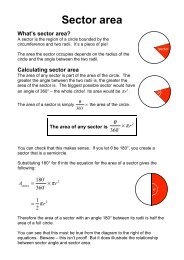
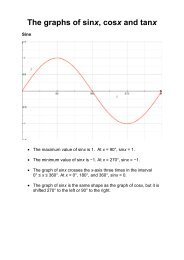
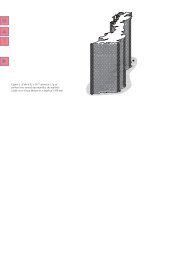
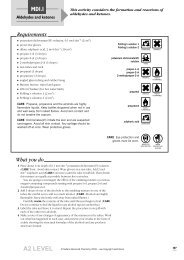
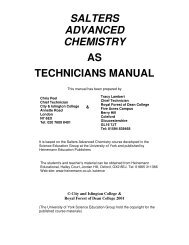



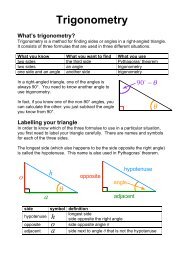
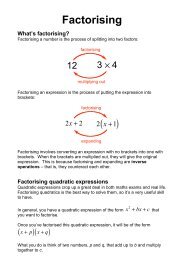
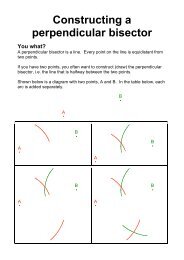


![ISI Web of Knowledge [v.4.10] - All Databases Results - Benjamin-Mills](https://img.yumpu.com/39253071/1/184x260/isi-web-of-knowledge-v410-all-databases-results-benjamin-mills.jpg?quality=85)